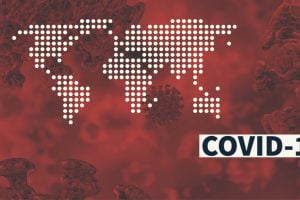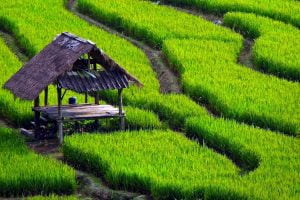
Recently there was official news that The Agency for Logistic Affairs (BULOG) would destroy rice reserves in its warehouse of 20 thousand tons, valued at IDR 160 billion (CNN Indonesia, 11/29/2019). This certainly adds to the length of the problem of food supply in Indonesia. Previously, there was an issue of accuracy of food data which became a polemic between BPS, Former Minister of Agriculture and 2019-2024 Minister of Agriculture.
At the upstream level in the process of food providing, there are problems of the agricultural land conversion which it seems uncontrolled. This is a serious threat to the sustainability of food agriculture in Indonesia. Another problem is that young people are no longer interested in becoming farmers. In the previous article (https://www.mamankh.com/ keeping up sustainability- land- agriculture- food-agar-sawah-itu-milik-pemda/) mentioned, out of 27 682 117 farm families in Indonesia – based on an inter-survey 2018 Census conducted by BPS – there are only 191 thousand farmers aged 25 years or younger. The rest are old farmers, between 40 years to 60 years. Therefore, our agriculture is threatened by extinction, it is feared that Indonesia will depend heavily on imported food .
Provision of Agricultural Land in Spatial Planning
It is an obligation for each Regional Government to allocate land for cultivation of food crops, especially rice, in the regional spatial plan. The allocation of land must be calculated based on the projected population growth that needs food, the chance of crop failure due to drought, flooding, and pests & diseases attack. By food supply at the local level – by each LG – the storage of rice reserves is not concentrated at the center, but rather at each LG.
As suggested in the previous article (https://www.mamankh.com/ keeping the sustainability of land-agriculture-food-food-rice-fields-yours-local government /), each local government should have the rice fields according to the projected needs of local residents. The LG should also have a Local Government Regional Owned Enterprise, in which it has a special task to produce and distribute the food to the community, and to carry out a strict supervision in food distribution. Therefore, the distribution of staple foods cannot be let to the market mechanism.
The allocation of land for food cultivation is a necessity to maintain the sustainability of food agriculture. However, the land allocated for farming is individual- farmers-owned land, because if this is done, it will cause a potential losses for farmers. When the land prices rise, the farmers will lose the opportunity to benefit from the increase in land. When there is a business opportunity to convert agricultural land to other uses, then the opportunity is closed to farmers. When farmers have a need to convert their land to settlements, businesses or other uses outside agriculture, it is also closed for the farmers.
Therefore, it is not surprising that farmers reject their land to be used as sustainable food agriculture area (SFAA) which should not be converted. Based on research on 100 sample farmers in Bangodua, Indramayu, West Java, there are six characteristics of farmers that strengthen farmers’ resistance to the SFAA plan. There are only two variables contributed to the tendency of farmers to accept the SFAA plan, namely the level of education and other employment outside the agricultural sector. The higher the level of education tends to be the higher the resistance of farmers to the planned f SFAA formation; and the lower the education level of farmers, the higher their acceptance of the planned SFAA is. This is not surprising because the higher the education level of farmers, they see the opportunity of the various other uses of land use besides farming. Therefore, the farmers with higher education, they tend to refuse the SFAA establishment plan. Oppositely, the lower the level of education, the farmers could not find any opportunities for land use other than farming. Therefore, the farmers with less education tend to accept the SFAA formation program (Table 1).
Table 1. The Relationship of Farmer Characteristic Variable with the Negative Tendency
of SFAL Formation
| No | Variable | Chi Square (X2) | p-value |
| 1 | Farmer’s Age | 0,022 | 0,881 |
| 2 | Number of Family Member | 0,603 | 0,437 |
| 3 | Farming Experience | 0,108 | 0,743 |
| 4 | Level of Education | 9,189 | 0,010** |
| 5 | Size of Owned Land | 2,070 | 0,355 |
| 6 | Farming Revenue | 3,101 | 0,212 |
| 7 | Outside Farming Work | 3,988 | 0,046** |
| 8 | Satisfaction of Seed Aids | 0,533 | 0,465 |
Note : **Strongly Significant
Sources: Processed from Apriyanti (2018)
Therefore, the land used for the formation of SFAA – in the context of maintaining the sustainability of the food agriculture sector – should be state-owned land. Each Regional Government is expected to be able to allocate state-owned land for food agriculture activities. In the case of absence of state owned land, the local government can buy land from the farmers. This is a food agricultural land that cannot be permanently converted. The local government, of course, must form a Regional Owned Enterprise to manage the land, produce rice, process and distribute the rice to the people. In this case the local government should have an appropriate cooperation scheme with farmer groups or united farmer groups in their respective regions.
Differentiating Basic Needs from Supporting Needs
In setting the policies to meet the needs of the community, the Government must carefully distinguish between basic and supporting needs. For basic needs, the Government must meet these needs. In this case, the Government is not only as a facilitator but as an executor. Meanwhile, to provide the supporting needs, the Government is only as a facilitator so that every individual citizen can fulfill his secondary or tertiary needs. Also the businessman in the field of providing secondary needs can run smoothly. For the distribution of secondary and tertiary needs, the Government can submit fully to the market mechanism. Every creative individual can carry out business activities in providing secondary or tertiary needs for individual citizens, whether as producers, agents, or retail traders.
It should be emphasized the rice is an important primary need (basic needs). Therefore, the supply and fulfillment of rice needs are fully provided by the Government. Each local government must have a rice field with an area as needed, have a company that manages the fields, processes rice, and distributes it. Individuals may also use their land for cultivation of food crops (rice), but it is optional, without pressure or coercion from the Government in order to cultivate their land. However, the core of rice providing is the government’s obligation. Local governments must predict the chances of crop failure, so there will be no shortage of rice. The stock preserved is merely to meet the needs of their respective regions, so that it is not concentrated in the center, and the amount is according to needs, so it will not be too much rice wasted if there is no catastrophic crop failure. In addition, the Regional Government – or the local government owned company as the representative of local government — must be creative in distributing the rice to avoid the wasted rice reserves. ***
Reference:
Apriyanti, Liana. “Respons Petani Terhadap Rencana Pembentukan Lahan Pertanian Pangan Berkelanjutan Di Kecamatan Bangodua Kabupaten Indramayu,” [The Farmer Response to the Planning of Formation of Sustainable Food Agricultural Area], The Thesis for Agribusiness Undergraduate Program FST UIN Jakarta, 2018.
CNN Indonesia, 11/29/2019);
Central Statistical Agency, 2018, The Result of Inter-Census Agricultural Survey 2018.



